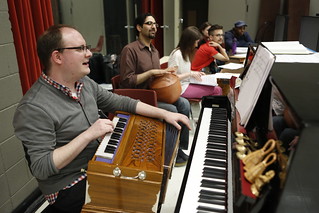“I was blown away by Mary Zimmerman’s transporting and visually stunning production. It immediately reminded me of what I love about her work – her big heart, sophisticated mind, and playful imagination. In this latest creation, she brilliantly interweaves Kipling’s evocative prose with the story of the classic film and marries traditional Indian instruments to its jazzy, instantly recognizable tunes. It’s a dream!”— Peter DuBois
Songwriter Richard Sherman and his brother Robert had not read Rudyard Kipling’s 1894 collection of stories when they were called into a meeting by Walt Disney to contribute to the development of a movie of The Jungle Book. It turns out that neither had any of the other animators or writers on the project. When Disney asked who of his team was familiar with the stories, not a person in the room raised his hand. “It was like a bunch of guys in school that hadn’t done their homework,” Richard Sherman remembers.
 Music Director and Orchestrator Doug Peck in rehearsal for The Jungle Book. |
Disney’s response? “Well, that’s good.” His reaction was genuine, as he wanted to create a film that discarded the dark, heavy mood of Kipling’s stories and instead embraced the delight that could be wrought from a medley of animal characters. The joy that infused the movie’s score with a playful spirit is one of the key elements adapter and director Mary Zimmerman strove to maintain in her new musical production.
The show, produced in association with Chicago’s Goodman Theatre, features seven songs from the Disney film including “The Bare Necessities” by Terry Gilkyson, never-before-heard songs by the award-winning Sherman Brothers, and more. “It’s going to be wonderful for the audience because they’ve never heard these songs before,” Sherman says. Music Director and Orchestrator Doug Peck has incorporated Indian sounds and underscoring based on themes from the film, as well as Indian ragas and dance music.
Peck believes that the music will prove even more powerful onstage than in the movie, especially as the production includes onstage musicians who will be encouraged to improvise throughout the run. “In the theatre, you are in the same acoustic space and can sometimes see the player or players creating the underscoring,” he says. “You are inherently more aware of the music, which can sometimes function on a more unconscious level on film. In some ways, I function both as arranger/orchestrator and editor helping players maintain a consistency that the cast can dance to, but also a freedom to explore their improvs from show to show.” The instrumentation consists of traditional western instruments such as a piano and drum set, as well as Indian snake trumpets, Carnatic violin, sitar, veena, tablas, ghattam, dholak, dhol, and other Indian percussion. Much of the Indian essence that Peck has infused into the score derives from the trip the creative team took to India.
The songs from the movie invite this added flavor, as each already has its own unique musical style that corresponds to the various species of animals. For instance, King Louie the Orangutan was conceived as a jazzman, so his number, “I Wanna Be Like You,” naturally fit as a swing piece.
The Sherman Brothers incorporated elements of Kipling’s stories and introduced whimsy and lightness to them, as per Disney’s instructions. Hathi, leader of the elephants, became Colonel Hathi, an officer in the British Raj who leads the militaristic “Colonel Hathi’s March.” The song plays with elephants’ natural galumph. As Sherman says, “It was all borne out of Walt’s desire for us to have fun.”
— Ali Leskowitz

No comments:
Post a Comment